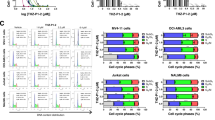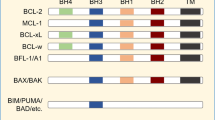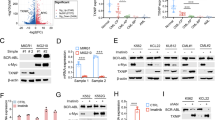Abstract
Although the BCR/ABL tyrosine kinase inhibitor imatinib is highly effective for treatment of chronic myeloid leukemia (CML) and Philadelphia-chromosome positive acute lymphoblastic leukemia (ALL), relapse with emerging imatinib-resistance mutations in the BCR/ABL kinase domain poses a significant problem. Here, we demonstrate that rottlerin, a putative protein kinase C-δ (PKCδ)-specific inhibitor, acts synergistically with imatinib to induce apoptosis of BCR/ABL-expressing K562 and Ton.B210 cells. However, rottlerin inhibited neither PKCδ nor BCR/ABL in these cells. On the other hand, rottlerin, previously characterized also as a mitochondrial uncoupler, transiently but significantly reduced mitochondrial membrane potential and gradually induced mitochondrial membrane permeabilization. Moreover, two other mitochondrial uncouplers, FCCP and DNP, very similarly induced apoptosis of BCR/ABL-expressing cells in a synergistic manner with imatinib. Imatinib synergistically enhanced mitochondrial membrane permeabilization induced by mitochondrial uncouplers, which led to release of cytochrome c into the cytoplasm and activation of caspases-3 and -9. Rottlerin also enhanced the cytotoxic effect of imatinib in leukemic cells from patients with CML blast crisis and Ph-positive ALL or a cell line expressing the imatinib-resistant E255K BCR/ABL mutant. The present study indicates that rottlerin synergistically enhances imatinib-induced apoptosis through its mitochondrial uncoupling effect independent of PKCδ and may contribute to the development of new treatment strategy to overcome the imatinib resistance and to cure the BCR/ABL expressing leukemias.
This is a preview of subscription content, access via your institution
Access options
Subscribe to this journal
Receive 50 print issues and online access
$259.00 per year
only $5.18 per issue
Buy this article
- Purchase on Springer Link
- Instant access to full article PDF
Prices may be subject to local taxes which are calculated during checkout







Similar content being viewed by others
References
Brenner C, Grimm S . (2006). The permeability transition pore complex in cancer cell death. Oncogene 25: 4744–4756.
Brodie C, Blumberg PM . (2003). Regulation of cell apoptosis by protein kinase c delta. Apoptosis 8: 19–27.
Chin H, Nakamura N, Kamiyama R, Miyasaka N, Ihle JN, Miura O . (1996). Physical and functional interactions between Stat5 and the tyrosine-phosphorylated receptors for erythropoietin and interleukin-3. Blood 88: 4415–4425.
Davies SP, Reddy H, Caivano M, Cohen P . (2000). Specificity and mechanism of action of some commonly used protein kinase inhibitors. Biochem J 351: 95–105.
Deininger M, Buchdunger E, Druker BJ . (2005). The development of imatinib as a therapeutic agent for chronic myeloid leukemia. Blood 105: 2640–2653.
Durrant D, Liu J, Yang HS, Lee RM . (2004). The bortezomib-induced mitochondrial damage is mediated by accumulation of active protein kinase C-delta. Biochem Biophys Res Commun 321: 905–908.
Echtay KS, Roussel D, St-Pierre J, Jekabsons MB, Cadenas S, Stuart JA et al. (2002). Superoxide activates mitochondrial uncoupling proteins. Nature 415: 96–99.
Goldman JM, Melo JV . (2003). Chronic myeloid leukemia – advances in biology and new approaches to treatment. N Engl J Med 349: 1451–1464.
Gschwendt M, Muller HJ, Kielbassa K, Zang R, Kittstein W, Rincke G et al. (1994). Rottlerin, a novel protein kinase inhibitor. Biochem Biophys Res Commun 199: 93–98.
Harper JA, Dickinson K, Brand MD . (2001). Mitochondrial uncoupling as a target for drug development for the treatment of obesity. Obes Rev 2: 255–265.
Hofmann WK, Komor M, Wassmann B, Jones LC, Gschaidmeier H, Hoelzer D et al. (2003). Presence of the BCR-ABL mutation E255K prior to STI571 (Imatinib) treatment in patients with Ph+ acute lymphoblastic leukemia. Blood 102: 659–661.
Hughes TP, Kaeda J, Branford S, Rudzki Z, Hochhaus A, Hensley ML et al. (2003). Frequency of major molecular responses to imatinib or interferon alfa plus cytarabine in newly diagnosed chronic myeloid leukemia. N Engl J Med 349: 1423–1432.
Jin A, Kurosu T, Tsuji K, Mizuchi D, Arai A, Fujita H et al. (2006). BCR/ABL and IL-3 activate Rap1 to stimulate the B-Raf/MEK/Erk and Akt signaling pathways and to regulate proliferation, apoptosis, and adhesion. Oncogene 25: 4332–4340.
Klucher KM, Lopez DV, Daley GQ . (1998). Secondary mutation maintains the transformed state in BaF3 cells with inducible BCR/ABL expression. Blood 91: 3927–3934.
Krauss S, Zhang CY, Lowell BB . (2005). The mitochondrial uncoupling-protein homologues. Nat Rev Mol Cell Biol 6: 248–261.
Kreuzer KA, Le Coutre P, Landt O, Na IK, Schwarz M, Schultheis K et al. (2003). Preexistence and evolution of imatinib mesylate-resistant clones in chronic myelogenous leukemia detected by a PNA-based PCR clamping technique. Ann Hematol 82: 284–289.
Kurosu T, Fukuda T, Miki T, Miura O . (2003). BCL6 overexpression prevents increase in reactive oxygen species and inhibits apoptosis induced by chemotherapeutic reagents in B-cell lymphoma cells. Oncogene 22: 4459–4468.
Liao YF, Hung YC, Chang WH, Tsay GJ, Hour TC, Hung HC et al. (2005). The PKC delta inhibitor, rottlerin, induces apoptosis of haematopoietic cell lines through mitochondrial membrane depolarization and caspases’ cascade. Life Sci 77: 707–719.
Mattiasson G, Shamloo M, Gido G, Mathi K, Tomasevic G, Yi S et al. (2003). Uncoupling protein-2 prevents neuronal death and diminishes brain dysfunction after stroke and brain trauma. Nat Med 9: 1062–1068.
Miura O, Cleveland JL, Ihle JN . (1993). Inactivation of erythropoietin receptor function by point mutations in a region having homology with other cytokine receptors. Mol Cell Biol 13: 1788–1795.
Ni H, Ergin M, Tibudan SS, Denning MF, Izban KF, Alkan S . (2003). Protein kinase C-delta is commonly expressed in multiple myeloma cells and its downregulation by rottlerin causes apoptosis. Br J Haematol 121: 849–856.
O’Hare T, Corbin AS, Druker BJ . (2006). Targeted CML therapy: controlling drug resistance, seeking cure. Curr Opin Genet Dev 16: 92–99.
Petronilli V, Miotto G, Canton M, Brini M, Colonna R, Bernardi P et al. (1999). Transient and long-lasting openings of the mitochondrial permeability transition pore can be monitored directly in intact cells by changes in mitochondrial calcein fluorescence. Biophys J 76: 725–734.
Poncet D, Boya P, Metivier D, Zamzami N, Kroemer G . (2003). Cytofluorometric quantitation of apoptosis-driven inner mitochondrial membrane permeabilization. Apoptosis 8: 521–530.
Ringshausen I, Schneller F, Bogner C, Hipp S, Duyster J, Peschel C et al. (2002). Constitutively activated phosphatidylinositol-3 kinase (PI-3K) is involved in the defect of apoptosis in B-CLL: association with protein kinase Cdelta. Blood 100: 3741–3748.
Roche-Lestienne C, Lai JL, Darre S, Facon T, Preudhomme C . (2003). A mutation conferring resistance to imatinib at the time of diagnosis of chronic myelogenous leukemia. N Engl J Med 348: 2265–2266.
Roche-Lestienne C, Soenen-Cornu V, Grardel-Duflos N, Lai JL, Philippe N, Facon T et al. (2002). Several types of mutations of the Abl gene can be found in chronic myeloid leukemia patients resistant to STI571, and they can pre-exist to the onset of treatment. Blood 100: 1014–1018.
Romanova LY, Alexandrov IA, Blagosklonny MV, Nordan RP, Garfield S, Acs P et al. (1999). Regulation of actin cytoskeleton in lymphocytes: PKC-delta disrupts IL-3-induced membrane ruffles downstream of Rac1. J Cell Physiol 179: 157–169.
Rothe G, Valet G . (1990). Flow cytometric analysis of respiratory burst activity in phagocytes with hydroethidine and 2′,7′-dichlorofluorescin. J Leukoc Biol 47: 440–448.
Shah NP . (2005). Loss of response to imatinib: mechanisms and management. Hematology (Am Soc Hematol Educ Program), 183–187.
Shah NP, Nicoll JM, Nagar B, Gorre ME, Paquette RL, Kuriyan J et al. (2002). Multiple BCR-ABL kinase domain mutations confer polyclonal resistance to the tyrosine kinase inhibitor imatinib (STI571) in chronic phase and blast crisis chronic myeloid leukemia. Cancer Cell 2: 117–125.
Shah NP, Tran C, Lee FY, Chen P, Norris D, Sawyers CL . (2004). Overriding imatinib resistance with a novel ABL kinase inhibitor. Science 305: 399–401.
Soltoff SP . (2001). Rottlerin is a mitochondrial uncoupler that decreases cellular ATP levels and indirectly blocks protein kinase Cdelta tyrosine phosphorylation. J Biol Chem 276: 37986–37992.
Temple MD, Perrone GG, Dawes IW . (2005). Complex cellular responses to reactive oxygen species. Trends Cell Biol 15: 319–326.
Tillman DM, Izeradjene K, Szucs KS, Douglas L, Houghton JA . (2003). Rottlerin sensitizes colon carcinoma cells to tumor necrosis factor-related apoptosis-inducing ligand-induced apoptosis via uncoupling of the mitochondria independent of protein kinase C. Cancer Res 63: 5118–5125.
Weisberg E, Manley PW, Breitenstein W, Bruggen J, Cowan-Jacob SW, Ray A et al. (2005). Characterization of AMN107, a selective inhibitor of native and mutant Bcr-Abl. Cancer Cell 7: 129–141.
Willis SG, Lange T, Demehri S, Otto S, Crossman L, Niederwieser D et al. (2005). High-sensitivity detection of BCR-ABL kinase domain mutations in imatinib-naive patients: correlation with clonal cytogenetic evolution but not response to therapy. Blood 106: 2128–2137.
Wong S, Witte ON . (2004). The BCR-ABL story: bench to bedside and back. Annu Rev Immunol 22: 247–306.
Yamamoto M, Kurosu T, Kakihana K, Mizuchi D, Miura O . (2004). The two major imatinib resistance mutations E255K and T315I enhance the activity of BCR/ABL fusion kinase. Biochem Biophys Res Commun 319: 1272–1275.
Yang J, Liu X, Bhalla K, Kim CN, Ibrado AM, Cai J et al. (1997). Prevention of apoptosis by Bcl-2: release of cytochrome c from mitochondria blocked. Science 275: 1129–1132.
Acknowledgements
We thank Drs George Q Daley and Larisa Y Romanova for the generous gifts of experimental materials. This study was supported in part by grants from Ministry of Education, Culture, Sports, Science and Technology of Japan.
Author information
Authors and Affiliations
Corresponding author
Rights and permissions
About this article
Cite this article
Kurosu, T., Tsuji, K., Kida, A. et al. Rottlerin synergistically enhances imatinib-induced apoptosis of BCR/ABL-expressing cells through its mitochondrial uncoupling effect independent of protein kinase C-δ. Oncogene 26, 2975–2987 (2007). https://doi.org/10.1038/sj.onc.1210117
Received:
Revised:
Accepted:
Published:
Issue Date:
DOI: https://doi.org/10.1038/sj.onc.1210117



